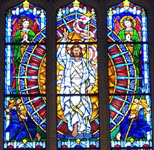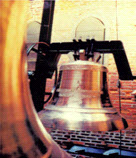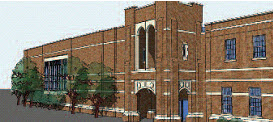FPC People-Family History Series
Why God selected our First Presbyterian Church family for centuries to be and remain a power beacon of light we do not know. We only know God tells us. “You did not choose me, but I chose you and appointed you to go out and bear fruit, fruit that will last.” JOHN 15:16
To learn more about the history of First Presbyterian Church, please download the following 5 letters that were part of the First Presbyterian Church Family History Series. These letters were presented by the First Presbyterian Church Long Range Planning Committee in conjunction with our “Growing In This Love” capital campaign.
Part One: Our Beginning – Persecution
Part Two: FPC Crisis – Epidemic and War
Part Three: Our Former FPC Buildings
Part Four: Our Current Sanctuary
Part Five: The Past 100 Years
Stained Glass Windows
 The use of stained glass windows in First Presbyterian Church, Norfolk dates back to the construction of the present sanctuary in 1912. The tower window picturing Christ in the Home of Mary and Martha was part of the dedication ceremonies on February 12, 1912. The window, along with half the money to construct the sanctuary, was donated by Mr. Frank Sheppard Royster. Designed by J & R Lamb Studios of New York, the window is in the opalescent glass popular at the turn of the century.
The use of stained glass windows in First Presbyterian Church, Norfolk dates back to the construction of the present sanctuary in 1912. The tower window picturing Christ in the Home of Mary and Martha was part of the dedication ceremonies on February 12, 1912. The window, along with half the money to construct the sanctuary, was donated by Mr. Frank Sheppard Royster. Designed by J & R Lamb Studios of New York, the window is in the opalescent glass popular at the turn of the century.
A discerning eye will notice small stylistic changes from the earliest Willet windows which are much darker, more detailed, with the painting baked in on both sides of the glass. Later windows, such as those dedicated in 1978, are painted only on one side and are slightly lighter in color tones to allowing more light to filter through. The newest windows, painted by Ann Willet, have more pastel colors, slightly heavier figures, larger pieces of glass, and a delicacy not seen in the other windows.
The overall iconographic theme, though never named as such, appears to be that of The Church Triumphant. The aisle windows in the nave show the Old and New Testament foundations for the life and ministry of Christ, represented in the clerestory and tower windows above. The chancel windows depict Christ of the Resurrection flanked by the two earliest leaders of the church. The lower windows in the transepts depict symbols of the church itself, communion, and the Presbyterian Celtic cross. The narthex windows make the theme specifically Presbyterian, depicting the leaders of the Presbyterian denomination.
Adapted from Stained Glass Windows in First Presbyterian Church, Norfolk, Virginia by Sally James, 1988
Church Bells
 Bell chimes have been associated with churches for centuries. The four bells in our belfry, a gift from Ann and Fred Martin dedicated January 2000, were given with the hope that their ringing will inspire listeners to reflect, pray, and praise God for the blessings He has bestowed on each of us.
Bell chimes have been associated with churches for centuries. The four bells in our belfry, a gift from Ann and Fred Martin dedicated January 2000, were given with the hope that their ringing will inspire listeners to reflect, pray, and praise God for the blessings He has bestowed on each of us.
The bells provide the following ringing: the TRADITIONAL CALL TO WORSHIP bell which is normally the largest bell swinging; a CELEBRATION PEAL consisting of all four bells swinging at their own rate of speed; the HOUR STRIKE followed by the traditional WESTMINSTER CHIME SEQUENCE; and the FUNERAL TOLL.
Organ

Gifted to the church by Dick and Shirley Roberts, the J. W. Walker pipe organ was designed specifically for First Presbyterian Church to enhance sacred music in the sanctuary and to be a blessing to the congregation for generations to come. An organ committee chaired by Terry Huffman and including members Carl Gatje, Bill Kent, Shirley Roberts, and Steve Wright selected J. W. Walker & Sons Ltd. of Brandon, Suffolk, England to build the new organ when maintenance, repairs, and upgrades on the organ original to the sanctuary (1911) became too costly. The organ was completely constructed in their workshop; disassembled and shipped across the Atlantic to Norfolk, VA, and reassembled at our church in the late fall of 1992.
J. W. Walker and Sons has a rich tradition of organ building expertise and is known for both its commitment to traditional craftsmanship and progressive outlook in organ design. The Main case, front console, with the addition of the 1994 West Organ became a four-manual console, with the ability to play all pipes from one location. The organ has seventy ranks of pipes and fifty stops. The Main and West Gallery consoles have 61-key manual compass, and 32-key spans in the pedals, with a 32-level memory system available at the Main console. This facility makes it possible to play music from the entire range of organ literature from both concert and liturgical styles.
Current Facility – “Growing In This Love”
Current Facility

“Growing In This Love,” a capital campaign launched in 2005, expands our current facilities while focusing on the very relationships that make all of our ministries so vital.
A new corridor connects the Sanctuary and First Hall to provide a central space for church members who worship at different times to come together.
First Hall seats 600 for worship and up to 400 for congregational meals.
Renovations provide a central area for our pastors and staff, as well as an expansion of the Preschool ministry.
"Growing In This Love," the theme for our capital campaign, is a reminder that it is the love of Christ that urges us forward, that calls us to grow, and that equips us for the future.



